List of Authors
>>About this blog
Recent blog post
|
[CAM]
December 26, 2015 20:00
We will continue to quote from "Snow Snow".
>・ ・ ・ ・ ・ ・ ・ ・ ・ ・ ・ ・ ・ ・ ・ ・ ・ ・ ・ ・ I went to Shiseido beauty salon. That's because there is a beauty salon on the basement of the hotel here, but in Shiseido, she is doing a new way of using a medicinal solution called Zotos, and it's easy without waiting for me to put electrical appliances etc. to my head, so I was told Mitsuyo last night that I should go there and get them there. ・... While waiting in the waiting room, there are only wives and daughters in Jun Tokyo whose surroundings are unknown, and no one speaks to me. Even if they talk in a whisper, they will be distracted by being heard of an upper accent, so as if they were in the enemy's place, they would be so sneakly listening to the conversation of the Tokyo dialect, which is often frustled around, but today I'm going to get a lot of them, and that's a great deal of beauty. ・・・・・・(862)
The expression "simmering yourself in the comfort of the enemy territory" often expresses the feelings of Kansai people when they came to Tokyo, and it is interesting.
>... I walked around Ginza in the morning, crossed the intersection of Owaricho 34 times over there, crossed here, had lunch at Hamasaku, and flew Taki Sea to Dogenzaka from the front of Awaya in Nishi Ginza. Taeko came along that day, saying that she was constantly tired or tired, and in Hamasaku's parlor, she threw her feet with a cushion as a pillow, but when the two sisters got on Taki Sea, she wanted to refrain from going, and because the family had to misunderstood himself, she would not have to say hello to her. ・・・・(867)
Current "Hamasaku" (Ginza 7-7-4)
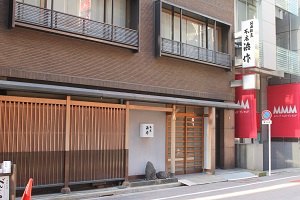
On the "Hamasaku" site, "Ginza" Honten Hamasaku ", Tokyo, was founded in Shinmachi, Osaka in 1924.
In 1928, it was the first Kansai Kappo restaurant in Tokyo to incorporate the style of counter Kappo cuisine, which cooks in front of customers in Ginza."
(correction) "" There were no four bridges from the Jumonji river to the river, but three bridges were built." Is probably Miyoshi Bridge in distance. Mitsuhashi is a little far away," he said, but from Konnyaku Island (Ringishi Island) and Shinkawa, "Mitsuhashi" is close, so this "three had bridges" means "Mitsuhashi" (Monoshiri Encyclopedia; page 40).
[CAM]
December 26, 2015 20:00
https://twitter.com/zmp_robot
I'm a resident of Tsukuda, Chuo-ku, but if you look at Twitter, it seems that ZMP's president Taniguchi, who is talking about now, is also jogging Tsukuda Kawai. Is your residence nearby?
ZMP says that Robo Taxi will be put into practical use by 2020.
By the time of the Olympics, Harumi-dori St. became like a special robot taxi zone, and it seems that it is not a dream that autonomous taxis run around between the athlete villages.
[CAM]
December 26, 2015 12:00
"Konjac Island" also touches the wind.
August 31, 1928 (1928), "The wiping of the sky is as intense as it is. ・・ ・ ・ Take a shared steamship from Shinohashi to Eitai Bridge. ・ ・ ・ ・ ・ ・ Walk between Auta and Konjac Island Geisha Shop and offer to Yakushido hall Kayabacho and return home after nine steps. I've already passed three days at night."
"Shinohashi" was replaced by a steel bridge in 1912. The current bridge was completed in 1976 (page 83 of Monoshiri Encyclopedia). Therefore, of course, the Shinohashi seen by the wind is not the current one.
"Konjac Island" The current Shinkawa area was called Reigishima (Ring Itsukushima) in the Edo period, and the contracted site for the Reigishi Bridge was reclaimed during the Kyoho period, and Tomijimamachi 1-2-chome was 1845 (1845) The land was formed by landfill on the west side of the island, but the coastal area of Kamejima River was insufficient. An Oka place was formed in the area, and the prostitute to which I belong was called Konjac Geisha.
"Reiganjima Monument" The origin of Reiganjima Island was erected by the Reiganjima Preservation Society in March 1977. (The installation location is 1-12-1, Shinkawa, Chuo-ku, Echizenbori Children's Park)
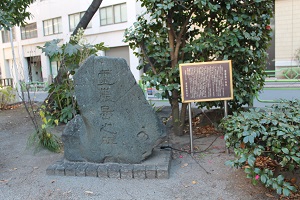
"In this area, 370-80 years ago, when the castle town of Edo was pioneered, it was a whole marsh Yoshihara. In 1624 (1624), the honorary Reiganji founded Reiganji Temple and took the first step in land development. In 1635, feudal lord Tadamasa Matsudaira of Echizen Fukui worshiped over 27,000 tsubo of Hamayashiki. Funairi moat was dug on the north, west, and south sides of the mansion, and later became the cause of the place name Echizen moat.
In the great fire of Edo in 1657 (1657), Reiganji Temple burned down and turned to Fukagawa Shirakawa-cho, the site became a public hall, and the towns in the city moved collectively as replacement sites.
The observatory was divided into 13 towns, Tomishima, Hamacho, Shiomachi, Okawabata, Kawaguchimachi, Nagasakimachi, Reiganjima, Shiroganemachi, Higashikomachi, Shinbune Matsumachi, Echizenbori, and Minami-Niihori. Everything became scorched by the Great East Japan Earthquake of the Taisho era, and in July 1931 (1931), the name of the town closely related to Shinkawa 1, 2-chome, Reiganjima 1, 2-chome, Echizenbori 1, 2-chome, and Echizenbori 1, 2, and 3-chome. In 1971 (1971), the new river and 2) were implemented. This monument is erected with concern that nostalgic archeological sites that symbolize the history from the Edo period are disappearing. "
"Kayabacho Yakushido hall" 165 pages of Shishiri Encyclopedia
[CAM]
December 25, 2015 20:00
We will continue to quote from "Snow Snow".
>... And I went to Owaricho again, and finally went to Hattori's basement, it was time for dinner, so Rome Iyaa did not change my mind, so I went up to the nu Grand near Sukiya Bridge because I had less time than going back to the inn and eating it, but for one of the reasons I was spared for a while tonight, I would have a good dinner table for a while. Then he hurriedly returned to the inn, packed the cargo, ran to Tokyo Station, stood up for five minutes in the waiting room with his sister who had come to see him off, and boarded the express sleeper that departed at eight thirty p.m. ・・・・・(418)
>... My sister said that I wanted to meet three people somewhere and eat together, so I wanted them to go around Ginza. When Taeko went to Ginza, she said she wanted to go to Nure Grand or Rome Iyaa, which she was listening to, so she decided to say Rome Iyaa, but I never went there, and how to get off at Sukiyabashi and go. (529)
Regarding "Lohmeyer" and "New Grand" that appear here, Yukio Mishima also wrote in "My Ginza" (February 1956 "Ginza Hundred Points") as follows.
>At that time, the New Grand part of the Mazda Building was transformed into red, blue, green and yellow, and threw the light of the searchlight.
When I was brought by my parents and went to the New Grand or Lohmeyer Restaurant, I was satisfied with the child-like vanity. ・・ ・ ・ ・ ・ ・ ・ (Completion of Reviews 2-251)
This "New Grand" was the opening of the Hotel New Grand in Yokohama on the 8th floor of the Mazda Building in Sukiyabashi in 1934 (Showa 9). The general manager of the Swiss restaurant seemed to have been taking care of the Yokohama store, and it was a fairly authentic French restaurant.
For this "Mazda Building" (Ginza TS Building, Toshiba Building), the description of the following site is quoted below.
![228-01[1]. jpg](https://en.tokuhain.chuo-kanko.or.jp/archive/228-01%5B1%5D.jpg) http://bb-building.net/tokyo/deta/228.html http://bb-building.net/tokyo/deta/228.html
Mosaic Ginza Hankyu (formerly Sukiyabashi Hankyu) was located at the corner of the Ginza Sukiyabashi intersection on the lower floor.
It used to be called the Mazda Building, and was headquartered by Tokyo Electric, one of Toshiba's predecessors. "Mazda" is derived from the licensed production of the incandescent Mazda lamp by Tokyo Electric Co., Ltd., and is not related to the automaker Mazda. Even after the merger with Shibaura Manufacturing Co., Ltd. in 1939 and became Tokyo Shibaura Electric Co., Ltd., the mark printed as "Mazda" continued to be used.
In 1956, Sukiyabashi Hankyu opened on the lower floor. It was expanded to the Shimbashi side in 1966. The exterior was also renewed and renamed the Ginza Toshiba Building. In 2007, Tokyu Land acquired a building for 161 billion yen and rebuilt it into a new commercial building, Tokyu Plaza Ginza.
![e250fb5b-468b-4f8f-b2f3-378592929c21_1[1]. jpg](https://en.tokuhain.chuo-kanko.or.jp/archive/e250fb5b-468b-4f8f-b2f3-378592929c21_1%5B1%5D.jpg)
"Tokyu Plaza Ginza" is scheduled to open on March 31, 2016 (Thursday). "Creative Japan - The world will be interesting from here. Based on the concept, it will be a commercial facility from the second basement floor to the eleventh floor above ground, which is the largest in the Ginza area.
As already introduced, the "Lohmeyer" restaurant seems to be operating in Nihonbashi under the name "Ginza Lohmeyer Restaurant Nihonbashi Store", and when you look at the site, "1925". Lohmeyer, the first restaurant in Ginza to start a full-fledged German restaurant. The authentic taste and heartwarming hospitality offered by founder Augst Lohmeyer, known for its first roast ham in Japan, has long been loved by many people as a famous Ginza store. The name is also appearing in Junichirou Tanizaki's representative "Snow Snow" announced in 1948. "
[CAM]
December 25, 2015 12:00
Regarding the Mitsukoshi Nihonbashi Main Store, the Monoshiri Encyclopedia has introduced the “Monoshiri Encyclopedia”.
>In 1904 (1904), he made a "Department Declaration" to realize one-stop shopping as the first department store in Japan and proposed modernization of lifestyle culture.
(page 31).
I would like to introduce Mitsukoshi's "Department Declaration" as follows in the Nikkei Shimbun morning column "Spring and Autumn" today (December 20, 2015).
>The way we have done so far must be fundamentally changed. If you take on the management, you will renew your face and make it a modern management. It seems that Ousuke Hibi, an executive of Mitsui Kimono Store (later Mitsukoshi), spoke like this in the mid-1930s (Masao Yamaguchi, "The spiritual history of the loser").
・・・・・・・・・・・・・
▼It was just 111 years ago. Hibi, who took full control of management while title as Senior Managing Director, started reforming immediately. A well-known one is a one-page advertisement published on the main paper early in the following year. "We will realize a part of the department store stoore that goes to the United States." It was the first department store declaration in Japan's retail business.
Current Mitsukoshi Department Store Nihonbashi Main Store
![IMG_2385[1]. jpg](https://en.tokuhain.chuo-kanko.or.jp/archive/IMG_2385%5B1%5D.jpg)
[CAM]
December 22, 2015 20:00
We will continue to quote from "Snow Snow".
>... In the afternoon, four people walked around Michiaki at the end of the pond, Mitsukoshi in Nihonbashi, Yamamoto of Noriya, Owaricho's collar circle, Hiranoya, Awaya in Nishi Ginza, etc. Unfortunately, it was a day when the remaining heat returned, but it was a day to shine, so I had to rest on the seventh floor of Mitsukoshi, Jaaman, etc. In spring, with a large number of shopping packages, he began to put his head out of his luggage, and even today he was sweating all over his face and coming from the traces of the three, but all three were hanging one or two. (417)
"Owaricho's collar circle" seems to be a former Japanese clothing store. It remains as "Parien Building" (Ginza 4-6-10), and there is a sign on the 9th floor, but is there no store?
The current "Parien Building" (a building with an advertising tower of a light blue insurance company on the roof. Shooting is December 20, 2015)
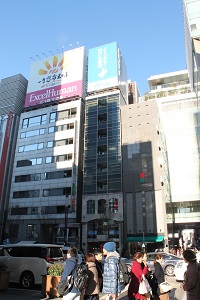
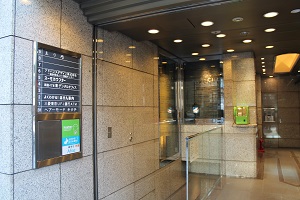
"Hiranoya" was founded in 1808 (5th year of culture) and ran a sword dealer in Nihonbashi, Edo. ・・ ・ ・ ・ ・ ・ (However, after the Meiji Restoration), swords became no longer sold on the front signboard, so they were treated as accessories that made use of techniques such as Kanuki, small pattern, Kogai (this is called three places). ・ ・ After that, the store was moved to Hamacho and the sword props, seal baskets, rooting, and chopped tobacco were put. ・・ ・ ・ ・ ・ ・ ・ ・ As a result of the land readjustment of the burnt ruins, it became inconvenient as a store around Hamacho 1-chome, so in the spring of 1934, Ginza 8-chome (currently Kinharu Street) Moved to The old buildings that escaped the war of World War II were familiar to everyone, but due to the effects of the bubble, it became impossible to rebuild, and now it is on the 5th floor of Tsuchiya Building on Ginza 6-chome Sotobori-dori St. We operate on the floor. " It seems that they are currently dealing with bags, wallets, and rooting.
Current Hiranoya (Ginza 6-4-5)
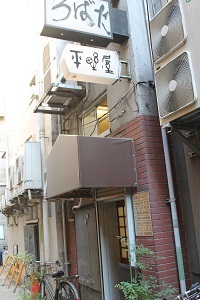
"Awaya" seems to be currently dealing with footwear and Japanese-Western umbrellas at Ginza 6-4-15 Tony Building. According to the company's website, "In 1871, it was founded in a place called Yakancho (currently Ginza 8-chome). Since then, we have been focusing on high quality and easy-to-wear footwear. In the early Showa era, he devised a sleigh with cowhide wrapped around the core of cork and gained a good reputation. This is the prototype of the current leather sleigh.
In addition, Awaya's footwear appeared in a passage of Junichirou Tanizaki's "Snow Snow", and we have gained the patronage of many customers. "Hand-sewn sleigh", which was hand-crafted by skilled craftsmen at the time, is still sold as a main product in order to be called a craft."
This "Awaya" also appears as a souvenir of Tokyo to Etsuko when Yukiko bought footwear and returned home.
>"Oh, thank you,"
"There's still one more thing, look below it. ── 」
"Oh, I did, this,"
So Etsuko took out the box wrapped in Awaya's paper in Ginza, but it was the red enamel sandals that came out of it.
"Oh, yes. I'm afraid I'm in Tokyo. ── 」
And while Sachiko picked it up and looked at it
"I'm going to take care of this, and wear it for the cherry blossom viewing next month."
"Oh, sir. Thank you very much, my sister," (222)
Here, "Take care of it" means "Take care of it" in the Kansai dialect. It is a typical example that is misunderstood when used in Tokyo (laughs).
|
Links
|
![228-01[1]. jpg](https://en.tokuhain.chuo-kanko.or.jp/archive/228-01%5B1%5D.jpg)
![e250fb5b-468b-4f8f-b2f3-378592929c21_1[1]. jpg](https://en.tokuhain.chuo-kanko.or.jp/archive/e250fb5b-468b-4f8f-b2f3-378592929c21_1%5B1%5D.jpg)
![IMG_2385[1]. jpg](https://en.tokuhain.chuo-kanko.or.jp/archive/IMG_2385%5B1%5D.jpg)

